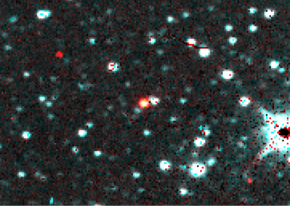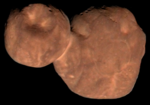 | |
| Discovery | |
|---|---|
| Discovered by | Jean-Jacques Blanpain (Marseille, France) |
| Discovery date | 1819 November 28/November 2003 |
| Designations | |
| Alternative designations | D/1819 W1; 2003 WY25 |
| Orbital characteristics | |
| Epoch | 1819 November 22 |
| Aphelion | 5.094 AU |
| Perihelion | 0.891 AU |
| Semi-major axis | 2.993 AU |
| Eccentricity | 0.702 |
| Orbital period | 5.18 yr |
| Inclination | 9.23° |
| Last perihelion | 2019-Dec-20 2014-08-28 2009-04-30 |
| Next perihelion | 2025-04-14 |
| Earth MOID | 0.015 AU (2,200,000 km) |
289P/Blanpain, formerly D/1819 W1 (Blanpain) is a short-period comet with an orbital period of 5.2 years. It was discovered by Jean-Jacques Blanpain on November 28, 1819 but was considered lost until it was recovered in 2013. It was last observed in 2020.
Observational history
The comet was discovered by Jean-Jacques Blanpain on November 28, 1819. Blanpain described the comet as having a "very small and confused nucleus". Another independent discovery was made on December 5 of that year by J. L. Pons. Following this the comet was lost, and was given the designation 'D' (Disappeared or Dead).
However, in 2003, the orbital elements of newly discovered asteroid 2003 WY25 were calculated by Marco Micheli and others to be a probable match for the lost comet. Further observations of the asteroid in 2005 by David Jewitt using the University of Hawaii 2.2 m telescope on Mauna Kea, appeared to reveal a faint coma, which supports the theory that 2003 WY25 is the lost comet, or a part of it. The comet was officially established as periodic comet 289P in July 2013, after being rediscovered by the Pan-STARRS survey during an outburst event.
289P was better viewed near and after the 2019-Dec-20 perihelion passage.
Source of Phoenicids
Comet D/1819 W1 has been proposed as the probable source of the Phoenicid meteor stream, since the first observation of a Phoenicids meteor storm in 1956. Analysis of the orbits of asteroid 2003 WY25 have supported this conjecture, and it is thought likely that the comet was already breaking up at the time of its 1819 return. The comet currently has an Earth-MOID of 0.015 AU (2,200,000 km; 1,400,000 mi).
References
- ^ "289P/Blanpain Orbit". Minor Planet Center. Retrieved 2017-04-09.
- M. Micheli, Astronomia UAI, 1:47, 2005
- David Jewitt, Comet D/1819 W1 (Blanpain): not dead yet, Astronomical Journal, 131:2327–2331, 2006 April
- P. Veres et al., CBET, 3574, 2013
- P. Jenniskens and E. Lyytinen, Meteor showers from the debris of broken comets: D/1819 W1 (Blanpain), 2003 WY25, and the Phoenicids, The Astronomical Journal, 130:1286–1290, 2005 September
- "JPL Small-Body Database Browser: 289P/Blanpain" (last observation: 2020-03-15). Jet Propulsion Laboratory.
External links
- 289P/Blanpain – Seiichi Yoshida @ aerith.net
- Gary W. Kronk's Cometography
- D/1819 W1 (Blanpain)
- METEOR SHOWERS FROM THE DEBRIS OF BROKEN COMETS: D/1819 W1 (BLANPAIN), 2003 WY25, AND THE PHOENICIDS
- Orbit
- Comet D/1819 W1 (Blanpain): Not Dead Yet
- IAUC 8485: D/1819 W1
- MPEC 2003-W41 : 2003 WY25
- P/1819 W1 = 2003 WY25 (Blanpain), MPEC
- CBET 3574: COMET P/1819 W1 = 2003 WY_25 (BLANPAIN)
| 2019 in space | ||
|---|---|---|
| Space probe launches |
|    |
| Impact events |
| |
| Selected NEOs | ||
| Exoplanets |
| |
| Discoveries |
| |
| Comets | ||
| Space exploration |
| |

